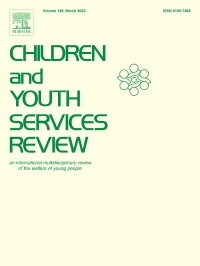 Youth development is inextricably tied to their family context. However, while systems of care (SOC) provide an array of wraparound services to youth with serious emotional and behavioral problems and have been proven effective overall, little research has been dedicated to analyzing how caregiver needs influence use of these services and affect youth outcomes. The vast majority of research on SOCs and wraparound care has focused on youth symptoms – understandable given that youth are the identified clients whose symptoms initiate care – with only a few examining broader family functioning.
Youth development is inextricably tied to their family context. However, while systems of care (SOC) provide an array of wraparound services to youth with serious emotional and behavioral problems and have been proven effective overall, little research has been dedicated to analyzing how caregiver needs influence use of these services and affect youth outcomes. The vast majority of research on SOCs and wraparound care has focused on youth symptoms – understandable given that youth are the identified clients whose symptoms initiate care – with only a few examining broader family functioning.
However, a more robust literature base examining youth in residential care settings and their families has revealed that caregivers of youth in those settings often have their own co-occurring needs, such as substance use, relationship problems, financial problems, mental health issues, domestic violence, and unemployment, and that the level of family functioning is strongly linked to treatment outcomes of the youth in care. For example, Sunseri (2020) found that youth of families with higher functioning at presentation to care are 1.6 times more likely to have a successful dischargefrom residential care when compared to youth whose families are lower functioning. But how should we define “higher functioning” and “lower functioning” when it comes to the caregivers and families of youth enrolled in outpatient SOCs? A new study co-authored by CHDI Associate Vice President of School & Community Initiatives Jeana Bracey took an important first step towards answering that question.
Read the journal article here >>>
The study, co-authored with Alayna Schreier, Madeline Stenersen, Michael Strambler, and Joy Kaufman of Yale University and Tim Marshall of CT Department of Children & Families and recently published in Children and Youth Services Review, aimed to identify and define categories of caregiver needs that could help SOCs design supports for caregivers whose own needs may impact their children’s use of and outcomes in SOC services.
The authors conducted a latent class analysis, believed to be the first of its kind, on data from a diverse group of 703 families enrolled in wraparound care coordination within the Connecticut Network of Care Transformation (CONNECT), a statewide partnership that strives to build a system of care that meets the behavioral health needs of all children in the state. Only families whose caregivers completed a survey on their needs at enrollment and who had received six-month follow-up assessments were included in the final analysis. The study also developed a survey for care coordinators to complete after each Child & Family Team (CFT) meeting which recorded variables such as number of meetings, average number of individuals in attendance, average meeting duration, percent of meetings with natural supports present, percent of meetings facilitated by the parent, and others. Mental health outcomes were reported by caregivers and collected at baseline and at six-month follow-up. Additional factors measured included caregiver strain, child trauma, and caregiver perceptions of care.
The analysis identified four main classes or categories of caregiver need: (1) physical health needs, (2) no needs, (3) basic needs, and (4) mental health/trauma needs, described below:
Caregiver Class 1: Physical Health Needs
Caregivers who had a physical illness/medical condition and lower levels of other needs categories.
Caregiver Class 2: No Needs
Caregivers who reported having no needs across any of the categories.
Caregiver Class 3: Basic Needs
Caregivers with moderate endorsement across multiple needs necessary for survival and basic functioning (e.g. poverty, unemployment, transportation). This was the largest class identified in the study sample.
Caregiver Class 4: Mental Health / Trauma Needs
Caregivers with a high probability of endorsing both mental health/substance use and domestic violence/trauma needs.
Though classes were named primarily after their most frequently identified caregiver need, it should be noted that classes named for one need do not exclude the possibility of additional caregiver needs present amongst individuals in that class. For example, though Class 1 is designated the Physical Health Needs class, approximately 20% of caregivers in this class also indicated that they needed help with transportation and/or mental health and substance use.
Analysis of youth symptoms at intake revealed several differences based on the caregiver’s needs class. For example, at intake, caregivers in the Physical Health Needs class reported significantly more youth trauma symptoms compared to those in the No Needs and Basic Needs classes and lower youth functioning scores than those in the Basic Needs class. However, findings indicated few differences in mental health outcomes based on caregiver need class, and showed significant improvement in youth outcomes regardless of the caregiver need class, suggesting that Connecticut’s statewide SOC is successfully meeting youth needs through wraparound care coordination. Yet there remain opportunities to better target and individualize care plans to meet the needs of youth and their caregivers.
By grouping caregivers into these need classes at entry into care, SOC providers can better predict how likely they are to engage in, benefit from, and complete the service. Gaining a better understanding of caregiver needs will enable care coordinators to further individualize SOC service provision, enhance youth and family engagement, reduce barriers to effective services, and improve outcomes. The authors also expect this study to help inspire and inform future research on this critical topic.
Read the full article in Children and Youth Services Review here.
Learn more about the Connecticut CONNECTing to Care Initiative here.